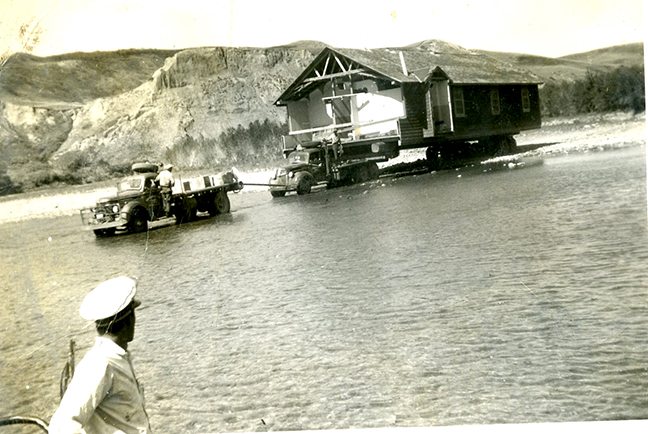Current Temperature
-2.4°C
Cranford Hall razed after long multi-use lifespan
Posted on March 27, 2025 by Taber Times Times Photo Submitted by Brenda Pyne. NAUTICAL ADVENTURE: Part of a collection of photos donated to the museum by Brian Layton in 2018, these undated images depict war surplus buildings being moved to Taber. It is speculated they were actually moved by barge upriver from Medicine Hat before being moved by truck up the river hill and into Taber.
Times Photo Submitted by Brenda Pyne. NAUTICAL ADVENTURE: Part of a collection of photos donated to the museum by Brian Layton in 2018, these undated images depict war surplus buildings being moved to Taber. It is speculated they were actually moved by barge upriver from Medicine Hat before being moved by truck up the river hill and into Taber. By Cal Braid
Taber Times
Local Journalism Initiative Reporter
Cranford Community Hall fell to ground earlier this year and the building that once stood in three locations –Taber, Cranford, and the Medicine Hat area – was reduced to rubble. Now it’s an empty lot.
The property where the hall used to stand was owned by Bill Taminga, who said he purchased the land roughly a decade ago. He let the hall stand before selling it and in early 2025 it was demolished to make way for redevelopment by a local drone business. Taminga has farmed land just north of Cranford for over 35 years.
According to the M.D. of Taber, for as long as the hall stood at that location, it was owned by the Cranford Community Recreation Society, which received yearly grant funding from the MD. However, “In 2014, the Hall faced financial challenges, and the Society approached M.D. council for assistance in clearing outstanding debts. Once those debts were resolved, the Society ultimately made the decision to sell the Hall,” said Carley Grant, communications officer at the M.D.
Taminga told us, “I think it came from Medicine Hat originally. It was a barracks or something.”
A history book from the Taber Irrigation Impact Museum commemorating 100 years (1905-2005) of town history says that W.R. Myers High School received two air force hangars which were relocated to Myers and used as a gym and an industrial shop. The hangars apparently came from a Medicine Hat-area military outpost, but once new school gymnasiums were built, one of the buildings was sold to Cranford for its use as a community hall.
Longtime Cranford resident Harry Halma filled in a few more details, saying, “I was involved when we got rid of it. There was no more interest from the community because we kind of depopulated. The young people were supposed to take over, but, well, that didn’t happen. And then, of course, the utilities kept piling up and kept piling up. So we decided, if there’s no more interest, we’re gonna sell it.”
Halma thinks the hall opened in Cranford in the mid-1950s, but recommended talking to some of the “old timers” because he was only involved in its last 10 or 12 years of operation. Our attempts to connect with “old timers” were unsuccessful.
Halma said Cranford was once busier with family farms, many of which had hired workers, and it was almost a community unto itself. “Cranford Hall was kind of the focal point,” he said. “Of course, during the summer time, in the 1970s, they would rent out the hall for family gatherings, camping or whatever they wanted, and that kind of paid for all the expenses.”
As for becoming “depopulated,” Halma said many of the generation of kids who were born into those farming families moved away to pursue other opportunities.
“Eventually, we had less family gatherings. And then when the highway came through, we had to give up quite a bit of property. All that took its effect,” he said.
What once used to be “lots of activity down on this road, the next road, and in this whole area” diminished, Halma said.
Leave a Reply
You must be logged in to post a comment.

